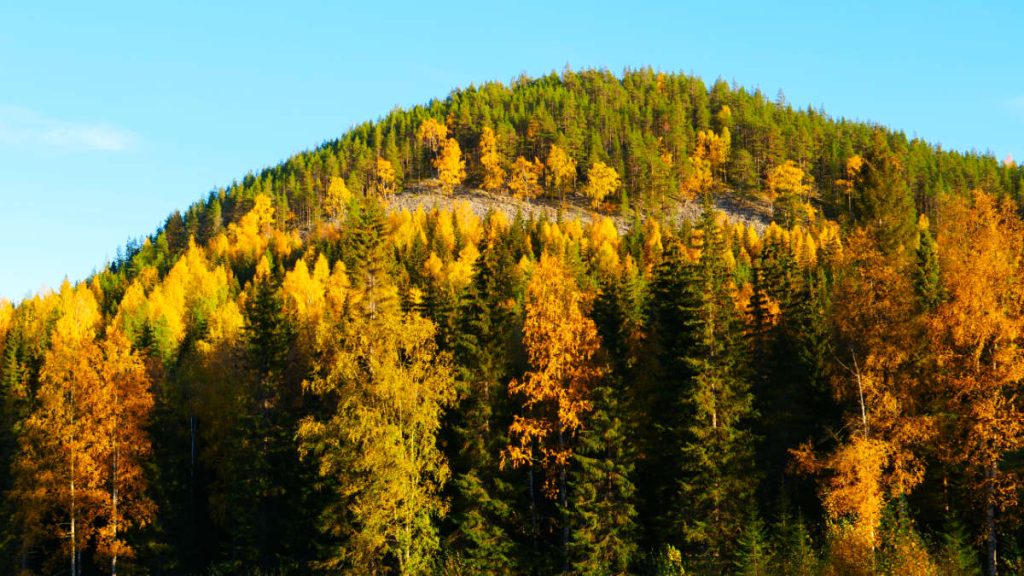Ragunda gamla kyrka
Church built with blocks of local rock
Ragunda gamla kyrka (old church) is a well-preserved church from the early 16th century. It was built of different rocks from Ragunda. On the bare church walls you can see the red Ragunda granite and the dark, almost black gabbro. Here you can also see rapakivi granite that is quite rare, has an odd appearance and crumbles easily.
Granite – one of the most common rocks
Granite is one of our commonest rocks. Depending on what minerals it contains, granite varies in colour. Mostly however it is light in colour with a hint of red. Granite contains a lot of quartz that may be white, grey or darker. It also contains red or white feldspar as well as black biotete and hornblende. The granite in Ragunda is called Ragunda granite.

Rapakivi granite – a rare granite that crumbles easily
Rapakivi granite is quite rare in Sweden and it is odd in appearance. The rock is most often meaty red with large crystals and a yellow-white shell. The colour of the crystals and the shell stems from two kinds of the mineral feldspar. The semi-transparent, grey grains are the mineral quartz. The word rapakivi is Finnish and refers to the two words ‘rapa’ meaning rotten or dirty, and ‘kivi’ that means stone or rock. The name refers to its character since rapakivi granite is easily worn down by water, wind and ice, it crumbles.

Gabbro – a dark rock worth mining
The dark, almost black rock is gabbro. The light grains in the gabbro are the mineral plagioclase. The dark mineral consists of pyroxene and amphibole. Gabbro is a valuable type of rock and may well be worth mining. It is often used in constructions.

Facts - Ragunda gamla kyrka
Ragunda gamla kyrka is a well-preserved stone church built in Gothic style that dates back to the first decade of the 1500s. The distinctive features of the church are the sections of red Ragunda granite. According to tradition the old church was built by the Dominican Order monk Josephus, vicar in Indal from 1480 to 1510.
When the new church in Ragunda was built the old church was abandoned. For nearly 80 years it remained empty before being reinstated in 1931.
Source: Svenska kyrkan.
Was formerly located at the edge of Lake Ragunda
On 6 June 1796 Magnus Huss - Vildhussen - was attempting to redirect the water past the 30-metre high waterfall Storforsen. Things did not go according to his plans and Lake Ragundasjön upstream from the waterfall was emptied in only a few hours.
Prior to the disaster the shoreline lay just below Ragunda gamla kyrka. The situation made it convenient for visitors to the church and services to come here across the lake by boat.
Following the emptying of Lake Ragundasjön the River Indalsälven dug into what had been the bottom of the lake.
The water level in the River Indalsälven is regulated for the production of hydroelectric power and is here about 35 metres below the old shoreline of Lake Ragundasjön.

More information
Sites to visit on Theme Continental Drift
More site photos



Places to visit nearby
Practicalities
Accessibility
See Accessibility.
Activities
Stop for a break and enjoy the fine views over the River Indalsälven. See also Activities in Ragunda.
Eating and drinking
During the summer Ragunda hembygdsgård is open. There they serve lunch and coffee. The nearest grocery store is in Hammarstrand. See also Eating and drinking in Ragunda.
Accommodation
Missing on site, but various options are available nearby. See Accommodation in Ragunda.
Getting here
SWEREF 99 TM N: 6 998 362 E: 569 042
WGS84 N: 63,108040° E: 16,368186°



